Employee morale is paramount to any company’s success.Whether we’re talking about a small startup or an established enterprise, low employee morale undermines your company’s operation in more than one way.
Low workplace morale leads to disengagement, low productivity, and even more sick days. Studies reveal that disengaged employees can cost U.S. companies up to $500 billion per year.
And yet, CareerBuilder’s survey found that 61% of employees are burned out on the job, with 31% reporting extreme stress levels. To prevent employee burnout, achieve high productivity levels, and foster a progressive workplace, you need to be proactive in keeping your employee morale high.
That’s where employee morale surveys come in. There are several types of employee morale surveys, each with its unique benefits.
Let’s go through them one by one.
#1. Remote Employee Morale Surveys
If you work in a remote team, tracking your team morale is a challenging task — most of the time, you can’t see your employees, let alone notice they struggle with something.
As a result, even simple issues can plague your team morale and productivity for months without even being addressed. Another challenge is that you can’t often correctly assign weight to the problem.
Your senior developers can struggle for months with onboarding juniors because you don’t have straightforward onboarding, but they keep their frustration to themselves. That slowly impacts their ability to write clean code. Meanwhile, a support operator who voices the recent angry customer complaint instantly becomes everyone’s center of attention, even though this isolated issue won’t have any long-term impact on your team’s productivity.
A remote team Scrum Master
The best way to address that is to conduct regular remote employee surveys. That way you will always have historic data over long periods of time inadequately indicating what issues, no matter how small they seem, discourage your employees on a regular basis.
Here’s how remote teams such as Shopify and Github use Geekbot to conduct remote employee surveys directly in Slack:
Open Geekbot dashboard and select the Team Feedback template under the “Surveys” tab:

Select team members you’d like to survey, when, and how often.
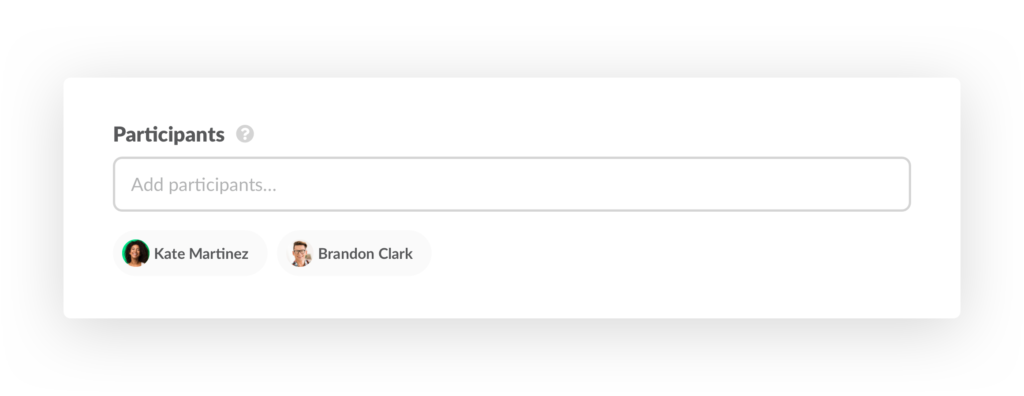
Geekbot will ask your team members a short series of questions related to their work and struggles at the selected time.
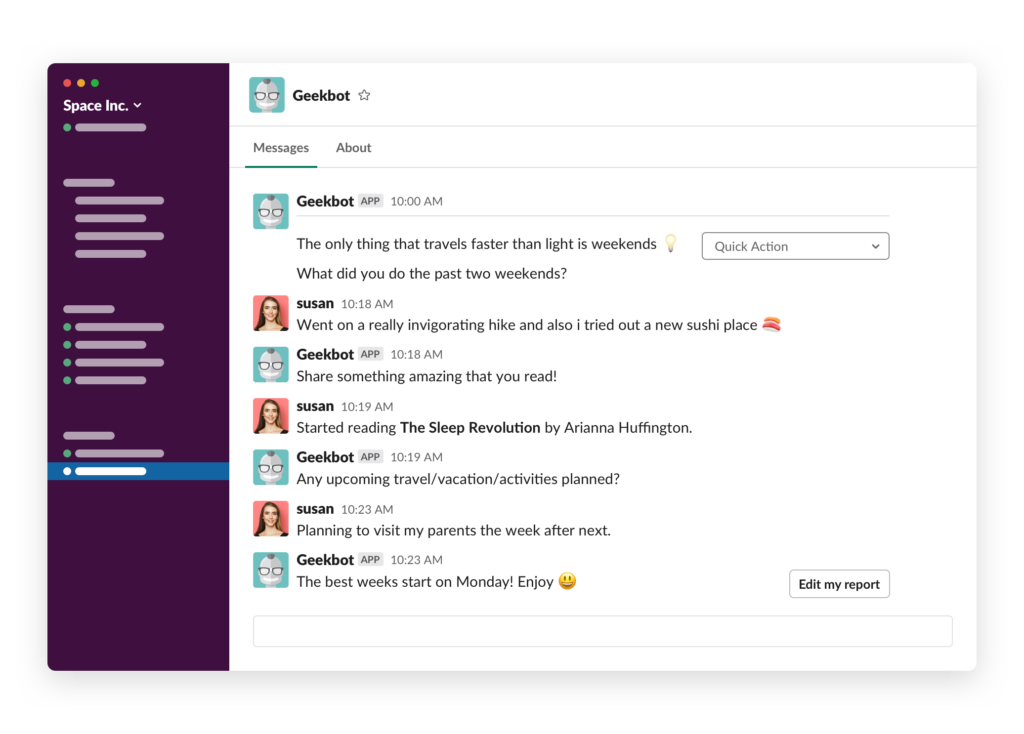
Geekbot then automatically gathers all team members replies in a designated Slack channel where you can analyze or follow up on responses:
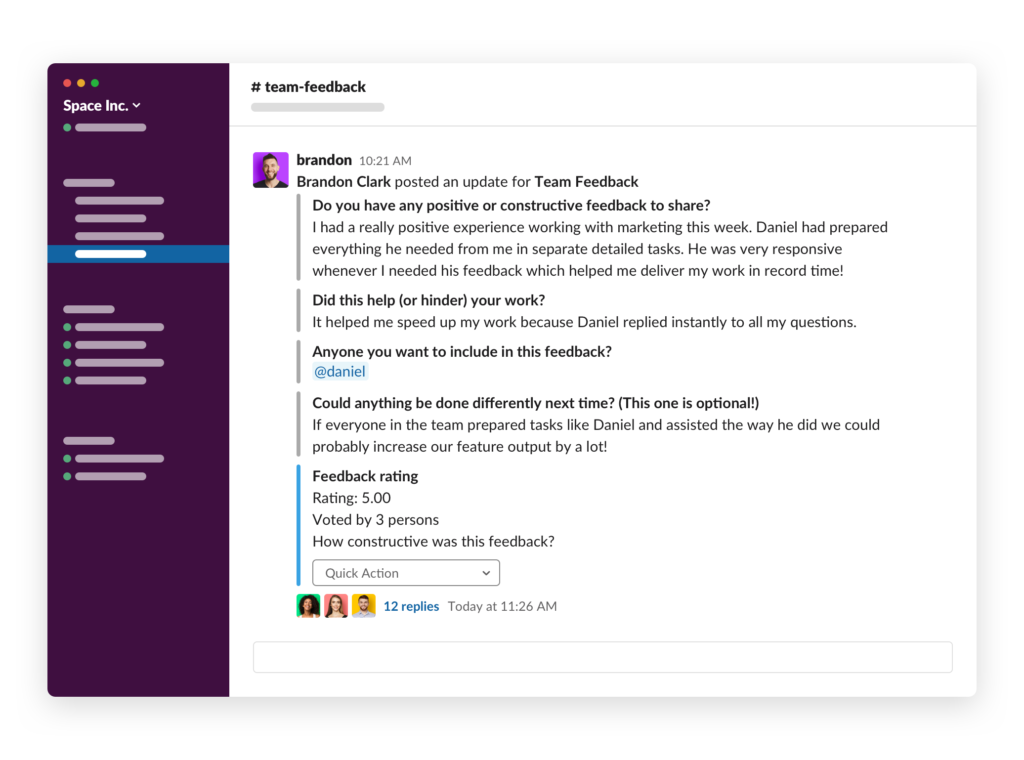
Let’s talk about more specific employee morale survey formats and when it’s best to use them.
#2. Well-Being Surveys
Often it’s hard to unearth specific issues that affect team morale simply because employees are not ready to share anything because of shyness, shame, or low-trust team culture.
Well-being surveys are specifically designed to be more approachable for the team members and set them at ease.
In other words, well-being surveys help resurface team issues without directly addressing them.
These surveys can be designed for regular check-ins or to address a specific topic or a recent event in the team.
Here’s an example of a Well-being check-in template that teams use with Geekbot for regular morale tracking:
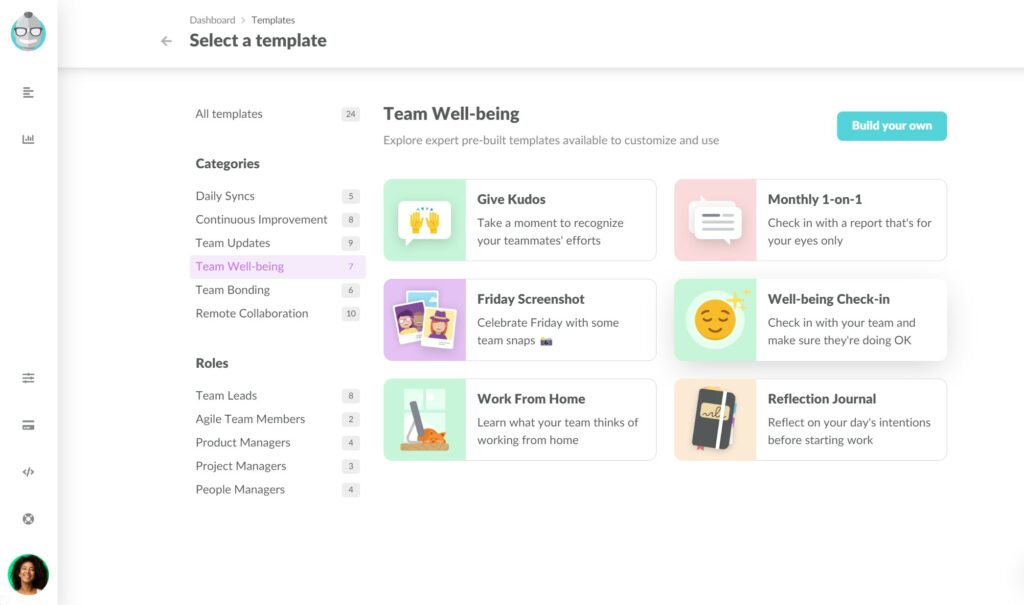
On same Team Well-being category you can find the Geekbot WFH template that is popular among teams who recently transitioned to working from home
You can and should constantly change and customize questions for your particular team environment.
For example, in larger teams, it’s recommended to limit the number of questions; otherwise, it gets too complex for team leaders to track and follow up on all answers. This might result in team members feeling ignored and discouraged.
#3. Monthly and Weekly 1-on-1
Google’s research project demonstrated that frequent 1-on-1 meetings with employees are a sign of high-performing leadership. These meetings give employee focus, facilitate workplace innovation, and even improve retention levels.
They also help you spot low morale issues, and not just those affecting a single employee, but your team as a whole. Employees look forward to these meetings when they feel like these are ongoing and beneficial conversations with their leadership, not just a one-off status report. And when employees trust their managers, it’s easy to uncover what hinders their morale and their team.
But for 1-on-1 meetings to be effective, they have to be regular and actionable. If you want employees to trust you, you need to constantly follow up on what was discussed before, reflect on their progress, and balance praise with feedback.
Hence, if managers want 1-on-1 meetings to be effective, they need to spend time on preparation. Managers need to review past meetings and figure out what employees need right now. But often managers try to figure everything out during the meetings, so half of the 1-on-1’s time is wasted on finding out what to talk about.
Managers also have to spend additional time gathering info before the meeting starts. With so much time spent, managers tend to either conduct meetings less often or wing them entirely, which affects both regularity and efficiency of these meetings.
Although 1-on-1 meetings can’t and shouldn’t be automated, there’s a way to boost their efficiency while saving both managers and employee’s valuable time.
Using Geekbot, managers can automatically send employees a list of prep questions before the meeting starts. Geekbot will then collect employee responses in Slack, allowing managers to review the answers and structure the meeting for maximum efficiency.
Here’s how Geekbot helps managers better prepare for 1-on-1’s directly in Slack:

Pick a Monthly 1-on-1 template in Geekbot’s dashboard. Here you can adjust your questions, frequency of these meetings (e.g., make them weekly), and choose team members who participate:
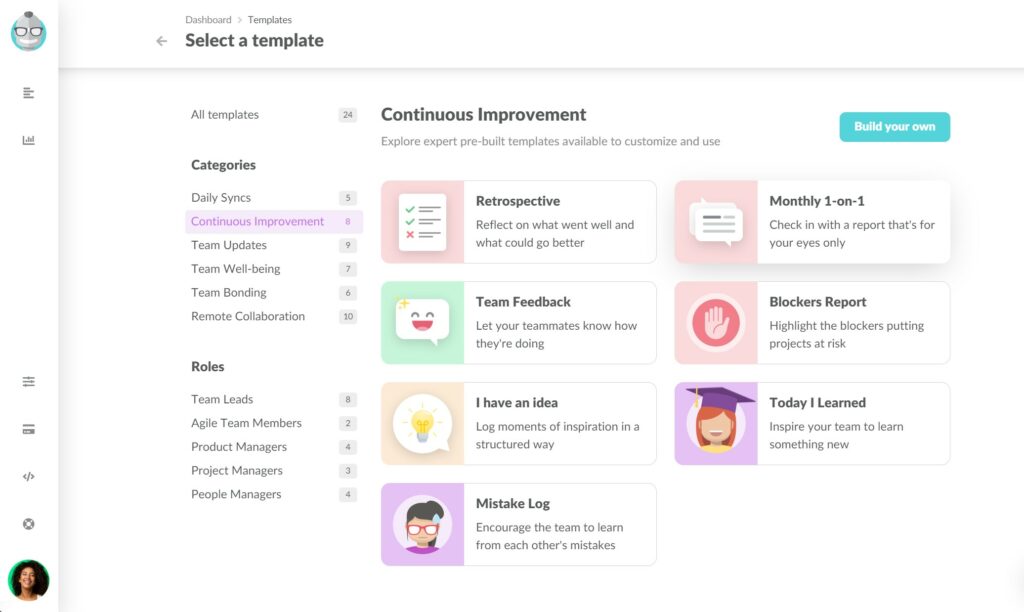
After configuring the 1-on-1 template to your needs, Geekbot works on autopilot to collect regular 1-on-1 feedback from your team members and store all teams responses in one place for easy access:
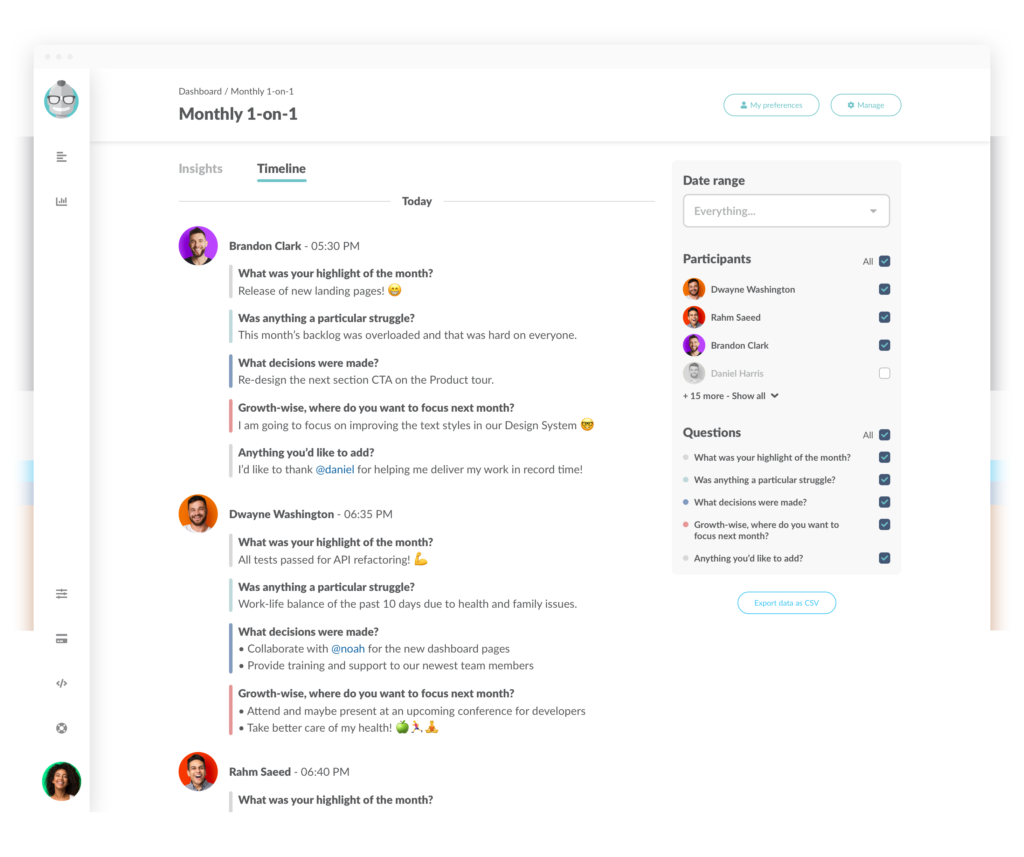
You can follow up on this information in any way you need, access historical data of all past responses to track progress, or reveal team issues when several of your team members focus on the same challenges in their responses.
The best part is that once configured, everything works autonomously, and neither you nor your team members have to spend hours preparing for 1-on-1 meetings, making them short, regular, and 100% actionable.
#4. Anonymous Surveys
Sometimes the best way to promote honest feedback from your team members is to survey them and respond anonymously.
This is especially true for low-trust environments where team members don’t feel comfortable voicing their opinions with leadership or other team members.
You can always use feedback gathered anonymously to understand why there’s such a low trust within your team and gradually improve your team’s culture to the point when everyone is ready to share their honest feedback openly.
In addition to that, anonymous surveys help team members to focus on questions rather than their responses.
There are several tools that let you run anonymous polls directly in Slack.
Geekbot also supports anonymous surveys and polls. Create your own survey or pick one from the Geekbot library of survey templates and toggle on “Anonymous answers” in the settings:
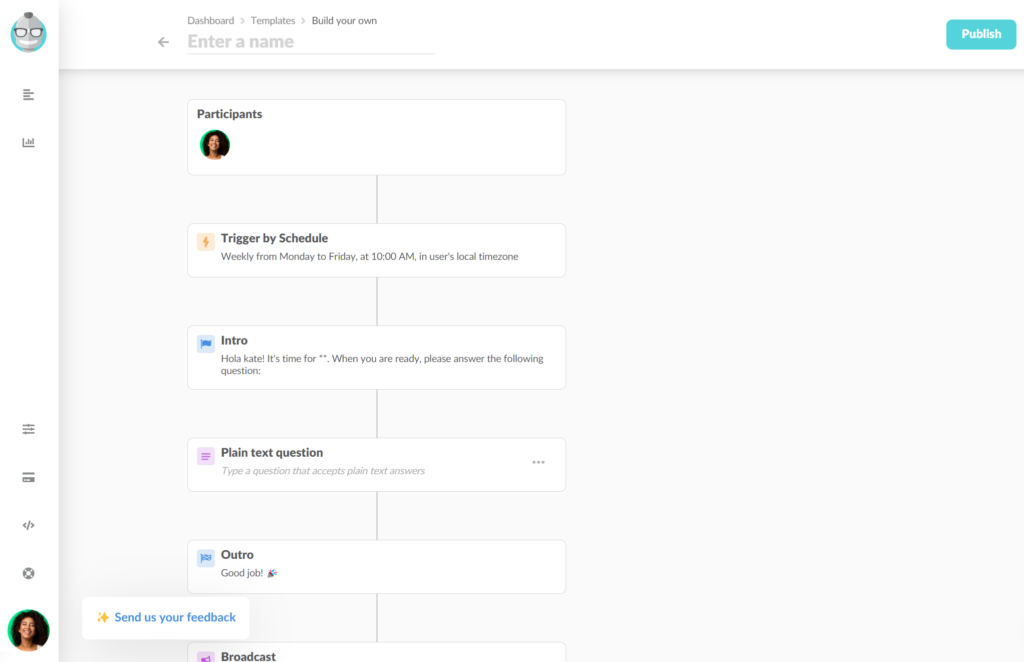
#5. Retrospectives
Retrospectives are one of the pivotal Scrum ceremonies. They are designed for team members to learn how to spot team-wide issues such as low morale and better solve them.
You can learn how to run actionable and engaging retrospectives in our step-by-step guide: What is a Sprint Retrospective and How to Run it?
In short, an effective retrospective consists of three key stages:
- Collect feedback and insights on current challenges
- Organize input to identify the most pressing team challenges
- Create an actionable plan to solving these challenges
And the best part is that you don’t have to spend hours doing all that. Asynchronous retrospectives in Slack take minutes and yet can be much more efficient than an average long-winded meeting.
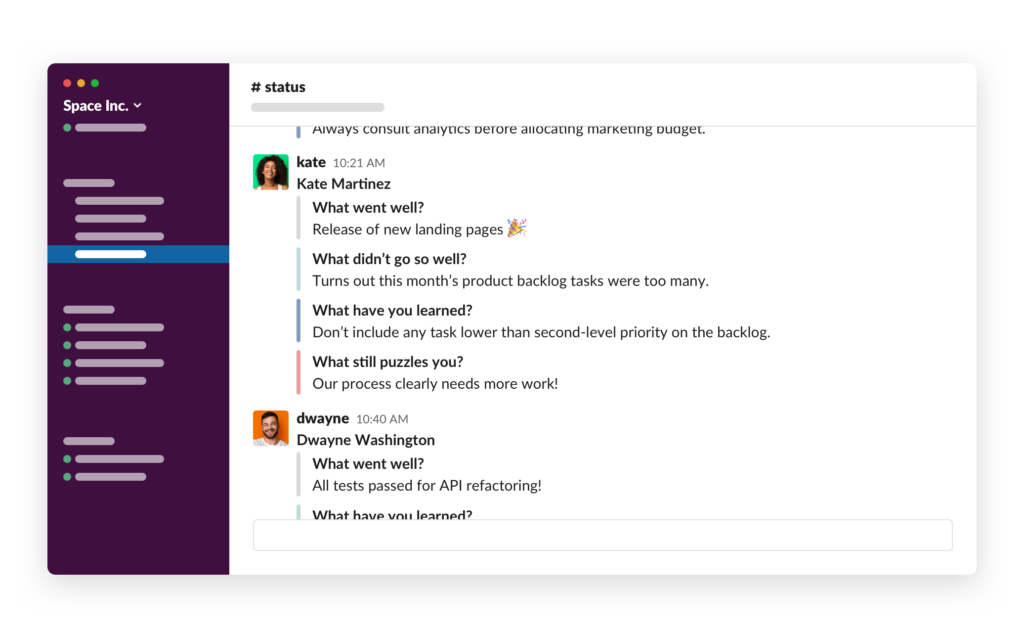
You can even break retrospectives into several short stages and run them on different days. Danny Verner, director of engineering at Vacasa, did just that: every team member spends just a few minutes per day, and yet every week, Danny has a complete picture of everything that affects his team and what to do with that.
#6. Access Data on Low Employee Morale You Already Have
Sometimes, especially if you are a data-driven company that relies on many tools to track its progress, you might already have useful data for spotting morale issues.
Here are some examples of data that you can use to spot low morale issues or research deeper into them:
- Measure sick days and absenteeism. Studies show that happy employees take fewer sick days. The reverse is also true: if your employees started taking more sick days than before that, you need to check in on them. Sometimes the reason might be their low morale.
- Measure work activity and work hours. Many remote teams use time trackers such as Hubstaff and Time Doctor to track working hours, but these trackers are also helpful in monitoring working activity. If you start noticing weekly or monthly activity drops it’s a good reason to start learning more with surveys and 1-on-1’s. (Source)
- Measure project progress. Productivity and employee morale go hand in hand. If your team is using project management tools to manage its projects, most of the tools offer some kind of reporting on project progress. Analyze task completion rates, project burndown charts, and tasks completed by team members or department and you might start uncovering productivity issues. (Source)
- NLP-tracking in messengers. Your Slack or MS Teams conversations are a goldmine of data about your team. But the problem is that this data is chaotic and almost impossible to use.
This is where Geekbot can help.
With Geekbot, you can apply NLP analysis to the most relevant messages of your team members. Geekbot already stores all team responses to daily scrums, well-being surveys, retrospectives, and anonymous surveys in designated channels.
But it goes beyond that. Applying NLP analysis to your team responses, the tool provides you with real-time graphs on team happiness levels:
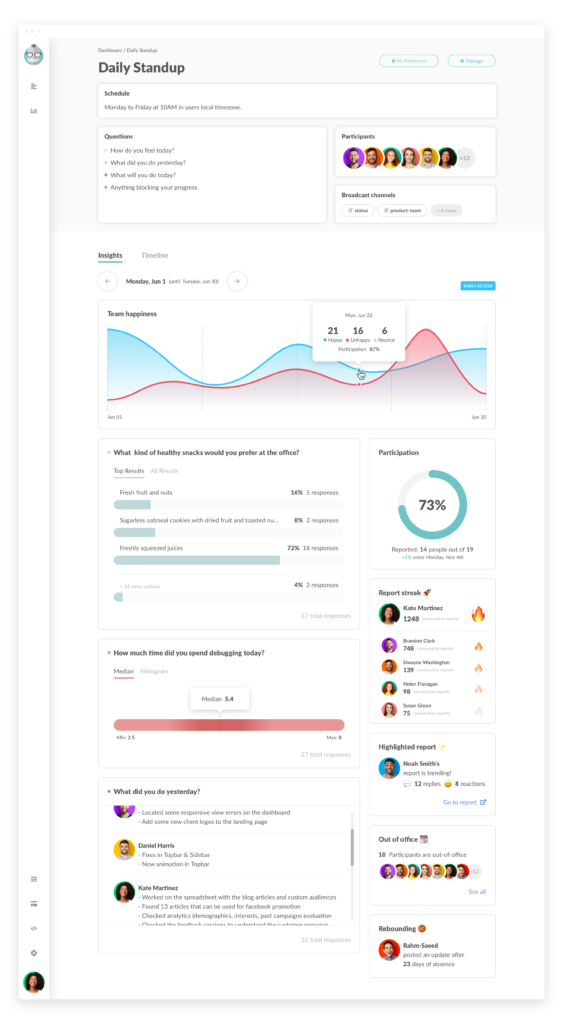
Analyzing these graphs, you can see any issues with your team morale. Some fluctuations you can explain easily: sudden surges after a fun team-building session or drops during a daunting release. But you’ll see much more than that. Historical data might show that after a certain date your team morale has been at an all-time low. You can identify the problem within a day timeframe and fix it.
We hope these employee morale survey tactics will help you to reveal any issues that plague your team morale. Ensure your team members are happy, and in return, they will do their best work for your company.
If you want an easy and effective way to identify and solve employee morale issues without wasting hours preparing custom surveys and tracking productivity, let Geekbot do all that for you.
Jump on our 10-people free plan and join ultra-productive teams such as Shopify, Github, and thousands of others who run effortless asynchronous meetings and surveys directly in their favorite messengers!
Frequently asked questions
How do you define employee morale?
A business or organization's morale is defined as an employee's attitude, level of satisfaction, and overall view of the organization or business. High morale usually results from employee motivation and satisfaction at work. Morale refers to employees' attitudes towards their work and the direction of the company.
What are good employee engagement questions?
Good employee engagement questions tend to produce both emotional and logical output from employees. Sich questions usually refer to some personal experience of an employee without, yet stay professional enough without crossing any personal border. A good question doesn’t spawn controversy among co-workers and instead fosters a productive discussion.
How do you measure employee morale?
There are several ways to measure employee morale. First, you can measure employee morale by conducting employee morale surveys and organizing feedback. The best way to measure employee morale is to support every survey with scale-based questions to ensure numeric input. Another way to measure employee morale is to analyze related performance data: activity levels, project progress, and absenteeism.



